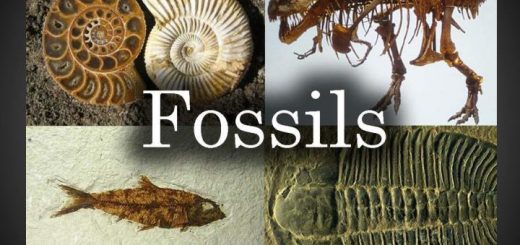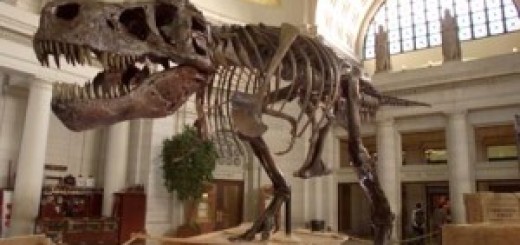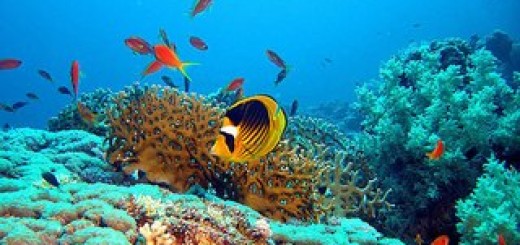Fossils types, mold, cast, petrified wood and Fossil of a complete body
Not all known fossils are considered as index fossils because the index fossils are the fossils of living organisms that lived for a short period of time in the past and had a wide geographic distribution, then became extinct and these conditions are not available in all fossils.
Concept of fossils
Fossils are considered as an exciting world (a story told by sedimentary rocks), that tells us about the deep past, million years ago even before the creation of man on the Earth. Fossils are traces and remains of old living organisms that are preserved in sedimentary rocks.
Traces of an old living organism indicate its activity during its life, such as worms’ tunnels and dinosaur’s footprint. Remains are traces that indicate the remains of an old living organism after death, such as remains of shark’s teeth and remains of a dinosaur’s skull. In Latin, the world fossil means something buried in the Earth. The science, which studies fossils is called “Paleontology”
Types of fossils
Fossils are classified according to the way of formation (or preservation) into several types, among them are:
- Fossil of a complete body
- Mold
- Cast
- Petrified fossils
Fossils of a complete body
It is a type of fossils, which was formed as a result of the rapid burying of the organism as soon as it died in a medium that preserves it from decomposition as snow or amber. Such as Mammoth fossil and Amber fossil.
A complete body fossil is a fossil that keeps the whole shape and all the details of the body of the living organism as a result of its rapid burying as soon as it died in a medium that preserves it from decomposition. Mammoth fossil is preserved as a complete body fossil because when it died, it was rapidly buried in snow which preserved it from decomposition.
Mammoth fossil: Mammoth (a type of elephant) was extinct by the snow avalanche that occurred in Siberia 25000 years ago. The first mammoth fossil, which was discovered last century, and keeps the whole shape, hair, flesh, and food in its bowel (stomach). After its death, the mammoth rapidly buried in snow which preserved its body from decomposition.
Amber fossil: During some old geologic ages there were common pine trees, which secreted resinous matter that changed after its solidification into amber. Amber is the solidified resinous matter, which was secreted by pine trees in the old geologic ages.
Insects were covered by the resinous matter which solidified and changed into amber that preserved the bodies of insects buried inside it from decomposition (decaying). Amber is considered a suitable medium for the formation of complete body fossils because it preserved the bodies of insects inside it from decomposition.
Mold
To make a model of a solid mold, paint the internal surface of the metal mold with oil using the brush, Mix plaster of Paris with water and continue stirring to make a suitable mixture, Pour the mixture in the metal mold and wait until the plaster of Paris solidifies, separate the hard mixture from the metal mold.
The details formed on the surface of the plaster are the same details of the internal surface of the metal mold. A replica of the internal shape of metal mold is formed and it is known as “solid mold”.
A solid mold fossil is the replica of the internal details of the structure of an old living organism left after its death in sedimentary rocks. Examples of solid mold fossils: Ammonites fossil, Nummulites fossil, and Trilobite fossil. Ammonites fossil is classified as a mold fossil because it is a replica of the internal details of the snail of ammonites.
How is the solid mold fossil formed?
- When a snail or clam dies, it falls on the seafloor, where its soft part decomposes leaving the shell which is buried in sediments.
- The sediments fill up the shell cavities and solidify as time passes.
- The shell decomposes completely, leaving a solid rock mold carrying the internal details of the snail.
How to make a candle mold?
- Melt a piece of paraffin wax or wax remaining in a water bath.
- Roll a piece of strong paper in the form of a cylinder then put it in an empty yogurt can then pass a thick thread through the cylinder using a needle.
- Pour the melted wax in the cylinder keeping the thread in the middle all time.
- Remove the paper from around the wax after its solidification and put the candle in a suitable glass saucer.
Cast
To make a model of cast: Get a colored clay and a shell of a clam, Then press on the clay with your hand to make a plane surface. Put the shell on the surface of the clay and press it gently, Remove the shell from the clay. The details formed on the clay are the same details of the external surface of the shell. A replica of the original external shell shape is formed and it is known as “Cast”
Cast fossil is the replica of the external details of the structure of an old living organism left after its death in sedimentary rock. Examples of cast fossils: Cast of ferns and fish cast. In sedimentary rocks, mold or cast can be formed for an old living organism after its death.
Mold and a trace
Mold is the replica of the internal details of the structure of an old living organism leaving them in the sedimentary rocks after death such as Ammonites fossils. Trace: Traces that indicate activity of an old living organism leaving them in sedimentary rocks during its life. such as Dinosaur’s footprint.
Petrified fossils
Petrified fossils are fossils in which minerals replace the organic matter of an old living organism, after its death, part by part leaving the shape without any change
Petrification is the process of conversion of the parts of old living organisms to rocky materials as a result of replacing the organic material of the organism with minerals, part by part. Examples of petrified fossils: Petrified dinosaur’s tooth, Petrified dinosaur’s eggs, and petrified wood.
Petrified wood is fossils that are formed as a result of replacing the wood material of trees with silica, part by part giving us details about the life of an old plant.
How is the petrified wood formed?
- The stems and trunks of trees that are more than 35 million years of age were buried in certain environmental conditions.
- The silica replaced the wood material (organic matter) part by part, and this is known as “petrification”
- By passing time, the wood changes into rocks, which carry the same details of wood without change.
Petrified woods are considered fossils although they look like rocks because they give us the details about the life of an old plant. Formation of petrified woods fossils due to replacing the organic matter of wood by silica part by part.
The area of petrified forests in Qattamiya is called the wood mountain because it contains petrified woods, which look like rocks. An Egyptian dinosaur has been discovered in Bahariya Oasis, Giza governorate and parts of it are being displayed in the Egyptian Geological Museum.
Suitable conditions for fossils formation (or preservation)
- Presence of the hard skeleton of an organism.
- The body of the organism must be buried immediately after death in a medium that preserves it from decomposition.
- The existence of a suitable medium in which the mineral material of rocks replaces the organic material of the living organism.
Importance of fossils
Fossils are important because they help in:
- Age determination of sedimentary rock.
- Figuring out the paleoenvironment.
- Studying life evolution.
- Petroleum exploration.
Age determination of sedimentary rocks
The scientists notice that: The lower layers of sedimentary rocks have fossils, whose relative age is greater than that of the fossils of the upper layers, these fossils are known as index fossils.
Index fossils are fossils of organisms that had lived for a short period of time in the past and had a wide geographic distribution, then became extinct. Index fossils indicate the age of sedimentary rocks that existed in them because the age of rocks is the same age of fossils that existed in them.
Nummulites fossils are considered as index fossils because they indicate the age of sedimentary rocks, as the age of rocks, is the same age of fossils that existed in them.
Figuring out the paleoenvironment
Fossils give us an idea about the environment, in which they lived during the old geologic ages, therefore they indicate the climate of these ages. Examples:
- Nummulites fossils are found in the limestone rocks of El-Mokattam mountain and they indicate that this area was a seafloor more than 35 million years ago.
- Ferns fossils indicate that the environment, where they lived was a hot and rainy tropical environment.
- Coral fossils indicate that the environment, where they lived was clear warm shallow seas.
Studying life evolution
Studying the fossil record showed that: Life started first in the sea then established on land. Organisms always developed from simple to complicated. Fossil record: The sequence of fossils in sedimentary rock layers according to their sequence of appearance from simple to complicated. In plant world, Algae appeared before Mosses and Ferns. Gymnosperms appeared before angiosperms.
In the animal world, Invertebrates like corals and mollusks with shells appeared before vertebrates, Fish were the first vertebrates that appeared followed by amphibians then reptiles, and finally, birds and mammals appeared together. Archaeopteryx fossil is considered a link between reptiles and birds.
Petroleum exploration
When searching for petroleum, geologists take samples from the rocks of the exploratory wells. These samples are studied under the microscope. If they contain microfossils like Foraminifera and radiolaria, this could point to:
- The age of rocks existed in exploratory wells.
- The suitable conditions of petroleum formation.
Fossils are important in petroleum exploration because the presence of foraminifera and radiolaria in the rocks of the exploratory wells indicate the suitable conditions for petroleum formation.
Fossils types, mold, cast, petrified wood & Fossil of a complete body
Natural protectorates, Reasons of extinction, Extinct & endangered species



